Final report for FNC17-1109
Project Information
We are new farmers on 84 acres of very diverse land. We raise pastured heritage breed pigs, plus heritage breed chickens and ducks. All our livestock is raised to organic standards and provided with locally-sourced feed.
We would like to establish systems including edible perennials and livestock in a way that increases the health and fertility of the soil, plants, and animals. Having minimal experience on this land, we consulted with an expert and mentor to help us decide how best to set up this system, particularly in terms of water management.
We wanted to test how well edible perennials respond to common water management approaches recommended in permaculture teaching. We planned to test combinations of four water-management techniques (a row of stacked brush just uphill of the planting row, a swale just uphill of the planting row, chisel plowing in the alley uphill of the planting row, and a control), but ran into some problems. After setting in on the project, we found the rows of brush would be prohibitively time-consuming to construct. We also couldn't find someone to chisel-plow for hire. But we did cut swales along two rows, so we can assess their effectiveness at capturing moisture compared to control rows.
We also wanted to test how edible perennials fare in the varying soil moisture conditions across the hillside test plot, so we planted varying combinations of tree, shrub, and vine species in blocks. This way, each species is placed in a few different regions of the test area, spanning elevation, soil moisture, soil type, and microclimate.
The 3-week drought that came after our 2017 planting had the biggest impact on our research, causing a 92% loss our first season, but our 2018 planting fared much better with the rainy summer, with a 77% loss.
We found that the rows with swales seemed to have drier soil than control rows, potentially due to moisture lost by the exposed soil of the actual swale cut. When species was controlled, plants in the swale rows fared better than plants in control rows.
Based on this research, I would recommend having at least simple low-cost contingency plans in effect for extreme events (like drought) to protect your investment. I would need to study the effect of swales over a longer time period before being able to speak for or against them, as their effects in this limited study were surprising and varied.
Our goals for the project were to: 1) design and plant an edible silvopasture on our farm despite our minimal experience, to 2) assess water management systems that would reduce the need for watering, and to 3) include community members and farmers in both our design and installation processes.
- To design an edible silvopasture with our minimal experience, we proposed hiring an expert to consult on our water management and planting design. We did this in April 2017 and came away with a plan and a mentor who guided us through the design process, accomplishing that goal.
- To assess water management practices as to whether they would improve establishment of trees and shrubs, we designed a rather complex planting system. As recommended by our expert/mentor, we arranged and planted mixed rows of trees and shrubs slightly off contour (sloping downhill at 1% grade from the valley to the ridge) to theoretically help distribute water more evenly across the hillside. Each row either uses swales for water management or remains a control, with no water management. This allows us to measure 1) whether swales actually provide more moisture to downhill plantings and 2) whether our slightly off-contour swale actually takes moisture from the valley and increases moisture in the ridge. We also planted the trees and shrubs in blocks, with different combinations in each row, so we could assess each species's health according to soil moisture and type. This allows us to assess both whether swales are beneficial and what each plant prefers in terms of soil moisture.
- To include farmers and community members in our design and installation process, we held a design workshop around the consultation and invited other farmers and community members. We had several regional and local farmers and landowners attend and have remained in contact with almost all of them to provide updates on the project. We also held tree-planting workdays where several community members learned about our project and assisted with the tree-planting portion.
Research
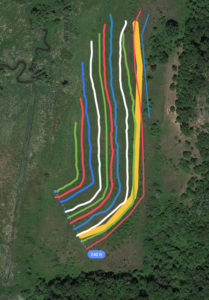 Having minimal experience on this land, we consulted with Mark Shepard to help us design this system. We structured the consultation as a workshop so others could learn from it. One main suggestion we took from this consultation was to plant our rows slightly off contour (sloping downhill at 1% grade from the valley to the ridge) to help distribute water more evenly across the hillside. By measuring soil moisture at several locations in each row and noting where samples are taken (particularly in relation to the valley and the ridge), we can assess whether this technique actually serves its intended purpose.
Having minimal experience on this land, we consulted with Mark Shepard to help us design this system. We structured the consultation as a workshop so others could learn from it. One main suggestion we took from this consultation was to plant our rows slightly off contour (sloping downhill at 1% grade from the valley to the ridge) to help distribute water more evenly across the hillside. By measuring soil moisture at several locations in each row and noting where samples are taken (particularly in relation to the valley and the ridge), we can assess whether this technique actually serves its intended purpose.
To see how well edible perennials respond to common water management approaches recommended in permaculture teaching, we planned to test combinations of four water-management techniques (a row of brush within 4 feet uphill of the row, a swale within 4 feet uphill of the row, chisel plowing in the alley uphill of the row, and a control), but found that the rows of brush would be prohibitively time-consuming to construct and couldn’t find someone to chisel-plow for hire. But we did cut swales along two rows, so we can assess their effectiveness at capturing moisture compared to control rows.
We wanted to test how edible perennials fare in varying soil moisture conditions, so we planted different combinations of tree, shrub, and vine species in 144-foot blocks across the test area. This way, each species is placed in a few different regions of the test area, spanning elevation, soil moisture, soil type, and microclimate. We did this so we could see where each species fared best.
We’ve learned that several sites on our land (including our first two choices for this project) have extremely shallow soils, so we’ve modified our plans for these areas in the future.
We were advised to move our rows slightly off contour to help water flow more evenly across the hillside, so we did that and took moisture measurements in the root zone area in each row to assess whether this actually works. However, we didn't have time to take moisture measurements before cutting the swales in 2017, so we know that the valley portion of the hillside is slightly moister than the ridges, but not how that differs from previously. Based on how quickly our swales drain in our sandy soil, I'd guess the change is minimal if anything. I had hoped to assess whether plants survived better in the valley than toward the ridges, but same-species placement varied both "horizontally" (within the row) and "vertically" (up or down the hill into different rows), which made it diffucult to compare.
We’ve seen that in heavy rainfall events, our swales catch and hold water, despite our soil being very sandy. We sampled soil and tested soil moisture approximately every 100 feet down each row and found that soil in the rows with swales just uphill of the plantings seem to be drier than the rows without swales, even accounting for the moisture variation based on elevation (drier uphill and wetter as the rows approach a marsh). This could be due to the exposed soil created by cutting the swale, which could cause drier conditions in the first year or two but this could change as the exposed swale surfaces are vegetated and covered.
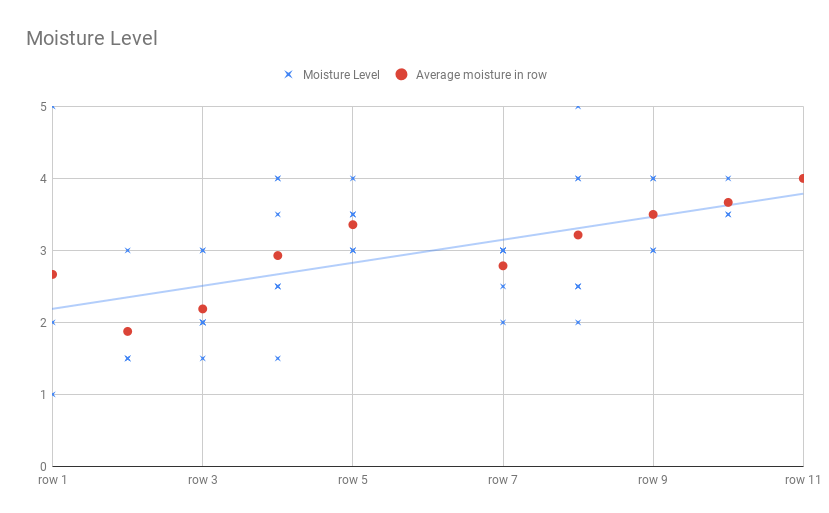
We also assessed the health and survival of every plant in 2018. We found that the 3-week drought following our 2017 planting had significant effects—less than 9% of what we planted survived, compared to over 23% of what we planted in 2018 (when abundant rain throughout the spring and summer watered our planting). We found that a lower percentage of plants survived in the swale than the control overall. However, when comparing swale versus control plantings of species planted in both (these comparisons are highlighted in yellow on the chart), the swale-planted ones almost universally had better survival.
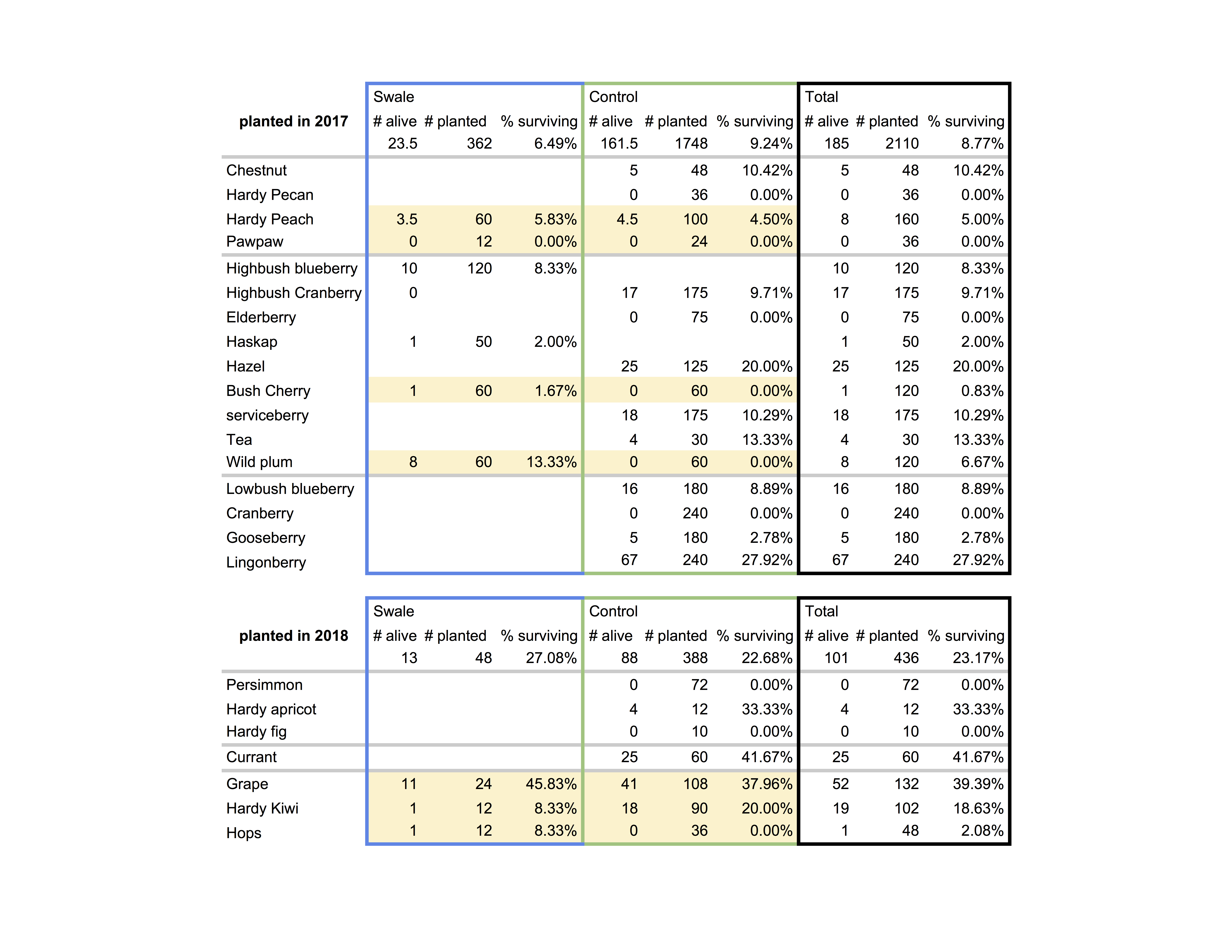
Overall, the low-input establishment of edible perennials certainly fared much worse than conventional practices. A commercial organic high-density apple orchard example involves about $16,000 (including 130 hours of labor) per acre (at about twice our density) in the establishment years. A conventional apple orchard example involves about $12,000 (including 130 hours of labor) per acre (at about our same density) in the establishment years. A conventional hazelnut orchard example involves about $3,000 (including 130 hours of labor) per acre (at about half our density) in the establishment years. Our project involved about $2400 (including 30 hours of labor) per acre. With an 11.23% overall survival rate, it is clear that measures beyond contour earthworks need to be taken when attempting to establish this many fruit and nut trees at once.
Educational & Outreach Activities
Participation Summary:
We held a permaculture farm design workshop and consultation, a mobile chicken coop (chickshaw)-building workshop, two contour marking workdays and three planting workdays. All were announced on our farm Facebook page, on the Savanna Institute Facebook page, on SARE's homepage, and in the Madison Area Permaculture Guild, Green County Women in Sustainable Agriculture, and Dane-Iowa County Women in Sustainability groups. The chickshaw, contour marking, and tree planting events were also announced on the FACT Humane Farming Forum group and to the Wild Harvest Nature Connection group.
The design workshop included 7 participants representing 4 farms. We've remained in communication with folks from 3 of those farms, sharing further learning and updates on our project.
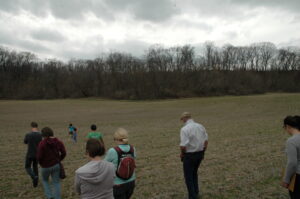
We had no off-farm participants in the chickshaw or contour-marking workshops, though we had some interested parties unable to attend on those dates.
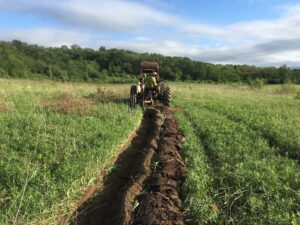
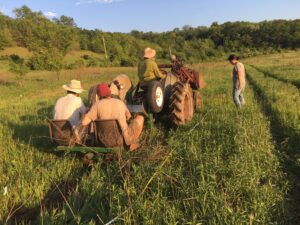
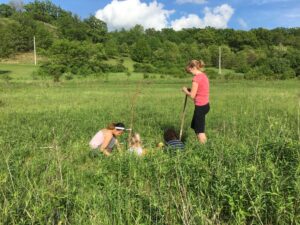
We had one hobby farmer volunteer his time to cut swales and pull the transplanter for tree-planting days, but the other four off-farm participants in planting are not currently farming.
We've posted updates on our Facebook page and plan to continue posting there. We presented our work briefly at the Savanna Institute’s Perennial Farmer Gathering in 2017 and 2018.
Learning Outcomes
So far, we’ve learned that several sites on our land (including our first two choices for this project) have soil less than 1 foot deep, so we’ve modified our plans for these areas in the future.
We learned about keyline design and the theory that angling rows slightly off contour will help water flow more evenly across the hillside by moving water downhill from the wetter valley to the drier ridges.
We learned an immense amount about surveying, which has already served us as we've begun to plan future water management projects.
We've learned about sourcing, purchasing, and planting edible perennials, which will be useful as we seek to purchase and plant vines this spring and as we look to replace any unhealthy plants in the future.